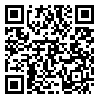Volume 25 - Special Issue
jrehab 2024, 25 - Special Issue: 604-635 |
Back to browse issues page
Download citation:
BibTeX | RIS | EndNote | Medlars | ProCite | Reference Manager | RefWorks
Send citation to:



BibTeX | RIS | EndNote | Medlars | ProCite | Reference Manager | RefWorks
Send citation to:
Takaffoli M, Vameghi M, Mowzoon H, Soleimani F, Ashour M, Hassanati F. Assessing Children’s Access to Speech Therapy Services During the COVID-19 Pandemic: A Qualitative Study. jrehab 2024; 25 (S3) :604-635
URL: http://rehabilitationj.uswr.ac.ir/article-1-3423-en.html
URL: http://rehabilitationj.uswr.ac.ir/article-1-3423-en.html
Marzieh Takaffoli1 

 , Meroe Vameghi1
, Meroe Vameghi1 

 , Hoda Mowzoon2
, Hoda Mowzoon2 

 , Farin Soleimani3
, Farin Soleimani3 

 , Maryam Ashour1
, Maryam Ashour1 

 , Fatemeh Hassanati *4
, Fatemeh Hassanati *4 




 , Meroe Vameghi1
, Meroe Vameghi1 

 , Hoda Mowzoon2
, Hoda Mowzoon2 

 , Farin Soleimani3
, Farin Soleimani3 

 , Maryam Ashour1
, Maryam Ashour1 

 , Fatemeh Hassanati *4
, Fatemeh Hassanati *4 


1- Social Welfare Management Research Center, Social Health Research Institute, University of Social Welfare and Rehabilitation Sciences, Tehran, Iran.
2- Department of Speech Therapy, Faculty of Rehabilitation Sciences, University of Social Welfare and Rehabilitation Sciences, Tehran, Iran.
3- Pediatric Neurorehabilitation Research Center, University of Social Welfare and Rehabilitation Sciences, Tehran, Iran.
4- Pediatric Neurorehabilitation Research Center, University of Social Welfare and Rehabilitation Sciences, Tehran, Iran. ,fatemehhasanati64@gmail.com
2- Department of Speech Therapy, Faculty of Rehabilitation Sciences, University of Social Welfare and Rehabilitation Sciences, Tehran, Iran.
3- Pediatric Neurorehabilitation Research Center, University of Social Welfare and Rehabilitation Sciences, Tehran, Iran.
4- Pediatric Neurorehabilitation Research Center, University of Social Welfare and Rehabilitation Sciences, Tehran, Iran. ,
Abstract: (4202 Views)
Objective Given the global emergence of the COVID-19 pandemic, notably in Iran, implementing preventive measures and protocols has constrained the accessibility of rehabilitation services, such as speech therapy. Among the demographic groups significantly impacted by the pandemic are children, who are particularly susceptible to adverse outcomes when faced with delays in receiving essential speech therapy services. Accordingly, this study explores the accessibility of speech therapy services for children in Tehran City, Iran, during the pandemic using a qualitative methodology based on the perspectives of speech therapists and caregivers.
Materials & Methods This study explored participants’ encounters with accessing services after the outbreak of COVID-19 and its associated determinants in Tehran City, Iran. This was achieved through comprehensive semi-structured interviews with speech therapists and primary caregivers of children, employing the conventional qualitative content analysis approach. The participants consisted of 9 speech therapists and 10 mothers until data saturation. They were interviewed and the data was analyzed using the MAXQDA software, version 2020.
Results The results explained the status of children’s access to speech therapy services in four main areas: reducing accessibility (delay in initial specialist diagnosis, change in the schedule of the treatment plan, change in the type of treatment plan), aggravating factors (basic factors, related to face-to-face services, and telepractice), modifying factors (associated with the macro health system, centers, telepractice, family, and child) and consequences (for the child and the family).
Conclusion The results demonstrated the dominant experience of reducing children’s accessibility to speech therapy services in Tehran City, Iran, especially in the first year. This experience has been dynamically affected by exacerbating and modifying factors, and over time, modifying factors have had a greater impact, or the power of aggravating factors has been mitigated. Hence, strengthening the modifiers and dealing with the factors that exacerbate the change in access should be addressed by service providers and policymakers both in normal conditions and to prepare for events similar to the COVID-19 pandemic.
Materials & Methods This study explored participants’ encounters with accessing services after the outbreak of COVID-19 and its associated determinants in Tehran City, Iran. This was achieved through comprehensive semi-structured interviews with speech therapists and primary caregivers of children, employing the conventional qualitative content analysis approach. The participants consisted of 9 speech therapists and 10 mothers until data saturation. They were interviewed and the data was analyzed using the MAXQDA software, version 2020.
Results The results explained the status of children’s access to speech therapy services in four main areas: reducing accessibility (delay in initial specialist diagnosis, change in the schedule of the treatment plan, change in the type of treatment plan), aggravating factors (basic factors, related to face-to-face services, and telepractice), modifying factors (associated with the macro health system, centers, telepractice, family, and child) and consequences (for the child and the family).
Conclusion The results demonstrated the dominant experience of reducing children’s accessibility to speech therapy services in Tehran City, Iran, especially in the first year. This experience has been dynamically affected by exacerbating and modifying factors, and over time, modifying factors have had a greater impact, or the power of aggravating factors has been mitigated. Hence, strengthening the modifiers and dealing with the factors that exacerbate the change in access should be addressed by service providers and policymakers both in normal conditions and to prepare for events similar to the COVID-19 pandemic.
Keywords: COVID-19, Coronavirus, Speech therapy, Child, Iran, Accessibility, Rehabilitation services
Type of Study: Original |
Subject:
Speech & Language Pathology
Received: 26/12/2023 | Accepted: 22/07/2024 | Published: 1/11/2024
Received: 26/12/2023 | Accepted: 22/07/2024 | Published: 1/11/2024
Send email to the article author
| Rights and permissions | |
 |
This work is licensed under a Creative Commons Attribution-NonCommercial 4.0 International License. |





